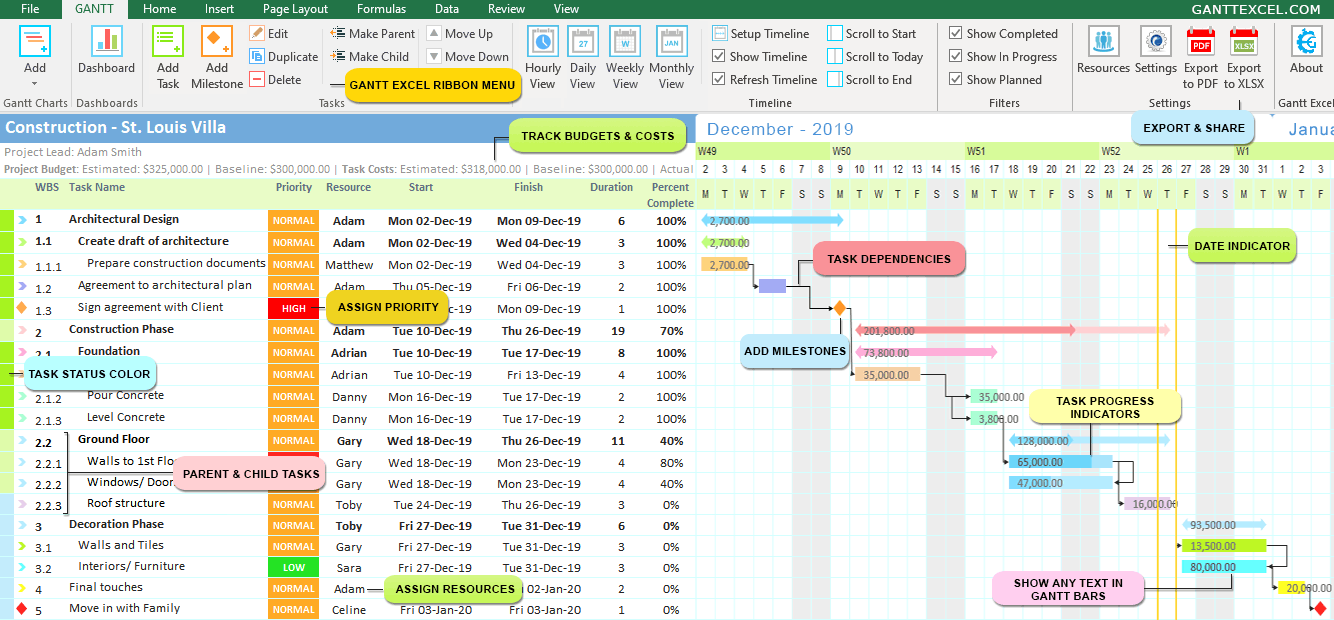A Gantt Chart is a popular project management tool that provides a visual of the tasks which need to be completed within the stipulated timeframe. Gantt Charts are excellent for tracking project schedules because they help you see interdependencies between tasks, especially when one tasks relies on another task to be completed. They also show progress, resources, constraints, and other relevant scheduling information.
A Gantt Chart simply represents information in a comprehensive way. It visually summarizes Tasks, Activity overlaps, Timelines, Budgets and Critical paths. All of this can be compiled effortlessly and with little work using the Gantt Chart software.
Henry Gantt, an American engineer and project management consultant in the year 1910 devised his own version of the chart which was widely known and popular. Consequently, it was Henry Gantt whose name was associated with charts of this type.
Gantt Charts can be created, updated and printed easily. They are most commonly used for tracking project schedules and to show additional information about the various tasks of the project, how tasks relate to each other, how far they have progressed, and the resources being used.
Gantt Chart Excel is everyone’s new favorite project management software with the ability to create Gantt Charts in minutes.
We all love Microsoft Excel and we use it almost every day for everything – from a simple calculator to tracking massive projects.
There’s just one thing that Excel is not good at and that is creating Gantt Charts . In fact a lot of users on the internet search for “How to Create a Gantt Chart in Excel?”.
For this reason, we created Gantt Excel, an automated excel template that allows you to create professional-looking Gantt Charts all within Microsoft Excel.
 Gantt Charts
Gantt Charts BENEFITS OF GANTT CHART IN PROJECT MANAGEMENT
- VISUAL REPRESENTATION OF PROJECTS
Gantt Chart makes it easier to represent complex tasks with the help of visually appealing bar chart format. It also helps in illustrating and monitoring multiple projects running at the same time. In this way, we store information about several projects in a central location and make it accessible to the whole team. It is easier for the employees to view and comprehend the information.
- BETTER COMMUNICATION
Replace your monotonous and tedious project meetings with the Gantt Charts which puts forth an enticing proposal of tracking the project’s progress easily. All the team members can view the project’s dynamic status updates and no time is wasted in conveying the information from one to another.
- SMOOTH COORDINATION
Gantt Charts makes it feasible to carry out sequencing of the tasks thereby reducing the burden on the team members. The project managers make use of the combinations of charts to break down complex projects into simpler and smaller tasks which foster stronger collaboration amongst the team members.
- TIME MANAGEMENT
Time is a crucial resource and its effective utilization makes a significant impact. A delayed project poses a big challenge and becomes a liability in the long run. The Gantt Chart helps in scheduling the projects leading to a better task organization. It is important to effectively allocate the time and control it for the resounding success of a project.
- CLEAR OFF TASK DEPENDENCIES
There are parallel and sequential tasks in a project. A few of them are dependent on each other for their successful completion. The Gantt Chart gives a clear view of the relationships between different projects and makes it seamless to organize the respective project structures.
- REDUCED COMPLEXITY
The Gantt Chart is a very efficient tool to get rid of intrinsic inevitable complexities when dealing with a number of tasks simultaneously. A comprehensible structure and user-friendly design make it easier to access the information and manage it. A Gantt Chart is made of horizontal and vertical lines to depict the data in great detail thereby reducing any confusion.
- PLAN AND SCHEDULE
Through a pictorial view offered by the Gantt Chart, it is easier to plan and map out the projects according to the timelines. A proper schedule paves the way for the better execution of a project and it is this area where the Gantt Chart helps immensely. It breaks down a big project into smaller subtasks and makes it simpler to complete them in a dedicated timeframe.
- ENHANCED TEAM PRODUCTIVITY
The Gantt Chart has the task assignment and progress being displayed publicly serving the need for tracking the progress of a project for every individual. This saves a lot of time and thus, productivity is scaled up.
- CLARITY
A Gantt Chart has the benefit of providing clarity to its users. Since complex information is spread and arranged in the pictorial representation, the team members can identify their own roles, responsibilities in the project management and the requirements of the project.
- FLEXIBILITY AND EFFICIENCY
Gantt Charts gives the benefit of viewing resource usage in a project which makes leveraging the efficiency of each employee trouble-free for the project manager. Also, as the project evolves there is a benefit of issuing new charts which gives a realistic view of the project development. Thus, Gantt Charts provides higher flexibility and enhanced efficiency.
